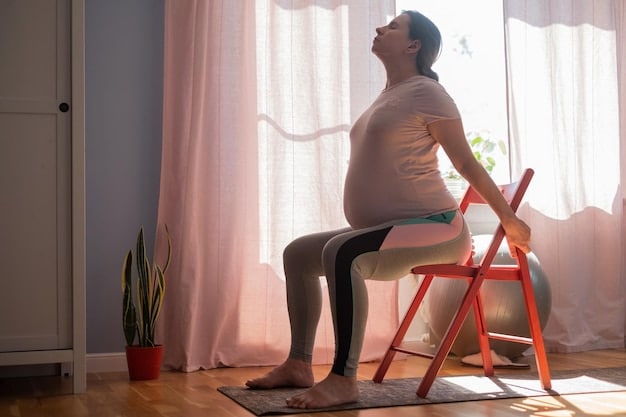Yoga for Pregnancy: Safe Poses for Each Trimester

Yoga for Pregnancy: Safe and Effective Poses for Each Trimester offers numerous benefits for expectant mothers, enhancing physical and mental well-being through carefully selected poses tailored to each stage of pregnancy.
Embarking on the journey of pregnancy brings about many changes, and maintaining a healthy lifestyle becomes paramount. Yoga for Pregnancy: Safe and Effective Poses for Each Trimester offers a fantastic way to stay active, manage discomfort, and prepare for childbirth.
Benefits of Yoga During Pregnancy
Practicing yoga during pregnancy offers a multitude of benefits. It’s not just about physical fitness; it’s also about mental and emotional well-being during this transformative period.
Yoga can help you connect with your changing body and your growing baby, providing a sense of calm and empowerment.
Physical Benefits of Prenatal Yoga
Prenatal yoga focuses on gentle stretches and poses that can ease common pregnancy discomforts. These physical benefits can significantly improve the overall pregnancy experience.
- Improved Circulation: Yoga improves blood flow, benefiting both mother and baby.
- Reduced Back Pain: Specific poses can alleviate lower back pain, a common complaint during pregnancy.
- Increased Flexibility: Gentle stretching enhances flexibility, preparing the body for labor.
- Better Sleep: Regular practice can promote relaxation and improve sleep quality.
Mental and Emotional Benefits of Prenatal Yoga
Pregnancy can be an emotional rollercoaster, and yoga offers tools to navigate these feelings. The mental and emotional benefits can have a profound impact.
- Stress Reduction: Yoga incorporates breathing techniques that lower stress levels.
- Emotional Balance: Regular practice helps stabilize mood and reduce anxiety.
- Mindful Awareness: Yoga encourages connecting with the present moment, reducing worries about the future.
- Preparation for Labor: Breathing exercises and relaxation techniques prepare the mind and body for childbirth.
In conclusion, incorporating yoga into your pregnancy routine can offer holistic benefits, addressing both your physical and emotional needs during this special time.
First Trimester Yoga: Poses to Embrace
The first trimester brings about significant hormonal changes and often comes with morning sickness and fatigue. Yoga during this stage should be gentle and supportive.
Focus on poses that ground you and provide stability while avoiding anything too strenuous.
Safe Poses for the First Trimester
Certain yoga poses are particularly beneficial during the first trimester. These poses are designed to be gentle and supportive.
Remember to listen to your body and modify poses as needed, consulting with your healthcare provider or a certified prenatal yoga instructor for personalized advice.
- Mountain Pose (Tadasana): Improves posture and grounds you, providing stability.
- Gentle Forward Folds: Eases tension in the back and calms the nervous system (modify by bending your knees deeply).
- Cat-Cow Pose: Gently mobilizes the spine and relieves back pain.
- Child’s Pose: A restorative pose that calms the mind and reduces fatigue (widen knees to accommodate your belly).
Poses to Avoid in the First Trimester
During the first trimester, it’s important to avoid certain poses that could strain your abdominal muscles or compromise balance. Some poses are best modified or avoided altogether.

Always check with your healthcare provider before starting any new exercise routine during pregnancy.
- Deep Twists: Avoid twisting deeply as it can compress the abdomen.
- Inversions: Poses like headstands and shoulder stands should be avoided due to balance concerns.
- Jumping or Bouncing: High-impact movements can be jarring and potentially harmful.
- Lying Flat on Your Back: Prolonged time on your back can compress the vena cava, restricting blood flow.
In summary, the first trimester calls for gentle, grounding yoga practices that support your body as it adjusts to pregnancy, avoiding anything that puts undue strain on your abdomen or causes dizziness.
Second Trimester Yoga: Finding Your Flow
The second trimester is often called the “honeymoon” phase of pregnancy, as morning sickness usually subsides and energy levels increase. Your belly is growing, but you might feel more comfortable and balanced.
It’s a great time to continue and adapt your yoga practice, focusing on poses that accommodate your changing body while maintaining strength and flexibility.
Poses Ideal for the Second Trimester
As your body adapts, you can incorporate a wider range of poses that continue to support your physical and emotional well-being. Modifications are crucial as your belly grows.
Always be mindful of your balance and stability, using props like blocks and bolsters to support your poses. Consulting with a prenatal yoga instructor can help tailor poses to your specific needs.
- Warrior II (Virabhadrasana II): Strengthens legs, opens hips, and energizes the body.
- Triangle Pose (Trikonasana): Stretches the spine and hamstrings (modify by using a block under your hand).
- Side Angle Pose (Parsvakonasana): Opens the hips and strengthens the legs.
- Supported Backbends: Gentle backbends using a chair or bolster can relieve back pain.
Modifications for the Second Trimester
As your belly grows, you’ll need to modify your poses to accommodate the change in your center of gravity and avoid compression of the abdomen. These adjustments are essential for safety and comfort.
Always listen to your body and adjust as needed, avoiding any poses that cause discomfort or strain.

- Wider Stance: Take a wider stance in standing poses to maintain balance.
- Using Props: Use blocks to bring the floor closer to you in forward folds and side stretches.
- Avoiding Deep Twists: Modify twists by focusing on opening the chest rather than twisting from the abdomen.
- Elevated Forward Folds: Bend your knees deeply in forward folds to avoid straining your back.
In conclusion, the second trimester is a great time to find your flow with yoga, modifying poses to accommodate your growing belly while maintaining strength, flexibility, and emotional balance.
Third Trimester Yoga: Preparing for Labor
In the third trimester, your body is preparing for labor and delivery. Yoga focuses on poses that help you stay comfortable, build stamina, and connect with your breath.
It’s also a time to practice relaxation and visualization techniques to prepare mentally for childbirth.
Poses for Labor Preparation
Certain yoga poses are specifically beneficial in preparing your body and mind for labor. These poses can help you develop strength, flexibility, and mental resilience.
Always consult with your healthcare provider and a certified prenatal yoga instructor to ensure the poses are safe and appropriate for your specific needs.
- Squats (Malasana): Opens the hips and strengthens the pelvic floor.
- Supported Reclining Butterfly Pose (Supta Baddha Konasana): Relaxes the hips and promotes relaxation.
- Wall Poses: Using a wall for support in poses like Legs-Up-the-Wall Pose (Viparita Karani) can relieve swelling in the legs and feet.
- Pelvic Tilts: Strengthens the abdominal muscles and alleviates back pain.
Breathing Techniques for Labor
Breathwork is a crucial component of prenatal yoga and can be particularly valuable during labor. Mastering these techniques can help you manage pain and stay calm.
Regular practice of these breathing techniques can empower you during childbirth. It’s advisable to take a prenatal class to learn these techniques properly under the guidance of a qualified instructor.
- Ujjayi Breath (Ocean Breath): Calms the nervous system and promotes relaxation.
- Dirga Pranayama (Three-Part Breath): Increases lung capacity and promotes deep relaxation.
- Alternate Nostril Breathing (Nadi Shodhana): Balances the nervous system and reduces anxiety.
- Cooling Breath (Sitali Pranayama): Cools the body and calms the mind (useful during hot flashes).
In summary, third-trimester yoga is all about preparing your body and mind for labor, focusing on poses that build stamina, promote relaxation, and connect you with your breath, empowering you for the birthing process.
Essential Yoga Props for Pregnancy
Yoga props can be invaluable tools during pregnancy, helping you modify poses, increase comfort, and support your growing body. Using props can make your practice safer and more enjoyable.
Investing in a few essential props can enhance your prenatal yoga experience and make a positive impact on your overall well-being.
Recommended Yoga Props
Certain yoga props are particularly beneficial during pregnancy. These props can help you adapt poses to your changing body and provide extra support.
- Yoga Blocks: Used to bring the floor closer to you in forward folds and side stretches.
- Yoga Straps: Helps to extend your reach in poses like seated forward folds.
- Bolsters: Provides support in restorative poses like reclining butterfly pose.
- Blankets: Can be rolled up to provide extra cushioning under knees or hips.
How to Use Props Effectively
Learning how to use yoga props correctly is essential for maximizing their benefits and ensuring your safety. Proper usage can enhance your practice and prevent injuries.
Consider attending a prenatal yoga class or workshop to learn how to use these props effectively under the guidance of an experienced instructor. This will help you customize your practice to your individual needs and body type.
- Blocks: Place blocks under your hands in forward folds to reduce strain on your back.
- Straps: Use a strap to loop around your feet in seated forward folds if you can’t reach your toes.
- Bolsters: Place a bolster under your back in reclining poses for gentle support.
- Blankets: Fold a blanket and place it under your knees in kneeling poses to cushion your joints.
In conclusion, yoga props are essential tools for adapting your yoga practice during pregnancy, providing support, increasing comfort, and helping you modify poses to meet your changing needs, ensuring a safe and enjoyable experience.
Creating a Safe Yoga Practice Environment
Creating a safe and comfortable environment for your prenatal yoga practice is crucial for your well-being. Your surroundings can significantly impact your ability to relax and focus.
Taking the time to set up your space thoughtfully can enhance your practice and create a positive experience.
Setting Up Your Space
Your yoga space should be clean, quiet, and free from distractions. Consider elements like lighting, temperature, and airflow to create a peaceful atmosphere.
- Choose a Quiet Location: Select a space where you won’t be disturbed.
- Ensure Good Ventilation: Proper airflow helps maintain a comfortable temperature and prevents stuffiness.
- Adjust the Lighting: Soft, natural light is ideal, but avoid harsh overhead lighting.
- Use a Yoga Mat: Provides cushioning and prevents slipping.
Listening to Your Body
One of the most important aspects of a safe yoga practice is listening to your body and honoring its limits. Pregnancy is not the time to push yourself beyond your comfort zone.
Always be mindful of how you feel during each pose and modify or rest as needed. It’s essential to communicate any discomfort or concerns with your instructor or healthcare provider.
- Avoid Overstretching: Gentle stretching is beneficial, but avoid pushing yourself too far.
- Stay Hydrated: Drink plenty of water before, during, and after your practice.
- Take Breaks: Rest in child’s pose or savasana as needed.
- Communicate with Your Instructor: Let your instructor know about any discomfort or concerns you may have.
In summary, creating a safe and supportive environment for your prenatal yoga practice, both internally and externally, is essential for your well-being and ensures a positive and beneficial experience throughout your pregnancy.
Common Mistakes to Avoid During Prenatal Yoga
While prenatal yoga offers numerous benefits, it’s important to be aware of common mistakes that can compromise your safety and well-being. Avoiding these pitfalls can ensure a more effective and enjoyable practice.
Education and awareness are key to navigating prenatal yoga safely and reaping its full potential benefits.
Mistakes to Watch Out For
Several common mistakes can be made during prenatal yoga. Being aware of these can help you modify your approach and improve your practice.
- Holding Your Breath: Proper breathing is crucial; avoid holding your breath during poses.
- Overexertion: Avoid pushing yourself too hard; pregnancy is not the time for intense workouts.
- Ignoring Discomfort: Listen to your body and modify or rest if you feel any pain.
- Skipping Modifications: Always modify poses to accommodate your changing body.
Staying Safe and Informed
Staying informed and taking precautions is essential for a safe prenatal yoga practice. This includes seeking guidance from professionals and staying attuned to your body’s signals.
- Consult Your Healthcare Provider: Get clearance from your doctor before starting any new exercise program.
- Work with a Certified Instructor: A qualified prenatal yoga instructor can guide you safely.
- Educate Yourself: Learn about safe poses and modifications for each trimester.
- Trust Your Intuition: If something doesn’t feel right, don’t do it.
| Key Point | Brief Description |
|---|---|
| 🧘 Safe Poses | Choose poses suitable for each trimester; avoid those that compress the abdomen. |
| 🫄 Modifications | Adapt poses with props and wider stances to accommodate your growing belly. |
| 🌬️ Breathing | Practice breathing techniques to calm the mind and prepare for labor. |
| 🩺 Consultation | Always consult with your doctor before starting or continuing yoga during pregnancy. |
FAQ
▼
Yes, with modifications. Consult your doctor and a certified prenatal yoga instructor for guidance on safe poses and adjustments appropriate for each trimester.
▼
Prenatal yoga can reduce stress, improve sleep, ease back pain, increase flexibility, enhance circulation, and prepare you mentally and physically for labor and delivery.
▼
Avoid deep twists, inversions, jumping or bouncing, and lying flat on your back for extended periods. Listen to your body and avoid any poses that cause discomfort.
▼
Yoga blocks, straps, bolsters, and blankets can help you modify poses, increase comfort, and support your body throughout your pregnancy. They aid in proper alignment.
▼
Look for instructors certified in prenatal yoga, with experience guiding pregnant women. Ask about their training and approach to modifications before attending a class.
Conclusion
Incorporating yoga for pregnancy: safe and effective poses for each trimester can greatly enhance your overall well-being during this transformative time. By understanding the needs and precautions specific to each stage, utilizing appropriate modifications and props, and listening to your body, you can enjoy a safe and beneficial practice that supports your physical, mental, and emotional health as you prepare for childbirth.





